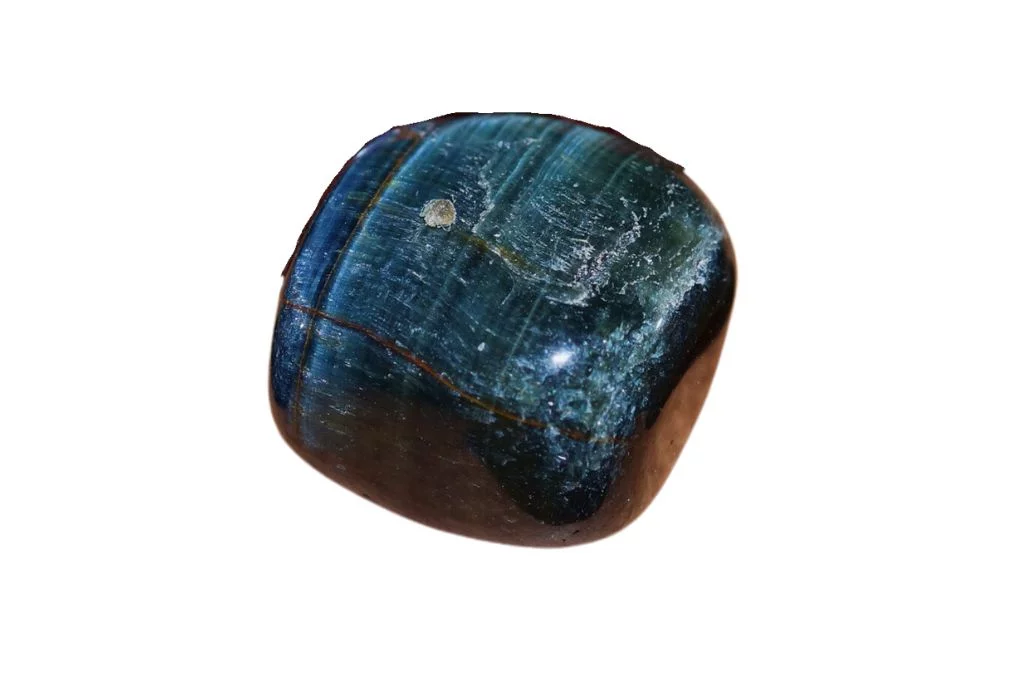Color and Appearance of Blue Tiger’s Eye
Blue Tiger’s Eye, also known as Hawk’s Eye, is a captivating gemstone characterized by its striking blue color and chatoyant effect. The stone typically displays a rich, deep blue hue reminiscent of the ocean depths. This color can range from a light sky blue to a more intense navy, depending on the specific specimen. The blue coloration is attributed to the presence of crocidolite fibers within the quartz structure.
Structural Composition
The crystal structure of Blue Tiger’s Eye is what gives it its distinctive appearance. It is composed of parallel fibers of crocidolite that have been replaced by quartz while maintaining their fibrous structure. This unique formation results in the stone’s signature silky, lustrous appearance and its ability to display a mesmerizing play of light across its surface.
Chatoyancy and Light Effects
One of the most notable characteristics of Blue Tiger’s Eye is its chatoyancy, also known as the “cat’s eye effect.” This optical phenomenon creates a shimmering, silky luster that seems to move across the surface of the stone as it is rotated. The effect resembles the vertical pupil of a cat’s eye, hence the name. This chatoyancy is caused by the reflection of light off the parallel fibers within the stone’s structure.
Unique Features and Variations
Blue Tiger’s Eye often exhibits bands or streaks of golden-brown, which are remnants of its transformation from Tiger’s Eye. These inclusions can create beautiful patterns and add depth to the stone’s appearance. Some specimens may also display a more mottled or patchy coloration, blending shades of blue with hints of grey or brown. The surface of the stone is typically smooth and can take a high polish, enhancing its reflective properties and overall beauty.
Historical and Cultural Significance of Blue Tiger’s Eye
Blue Tiger’s Eye, also known as Hawk’s Eye or Falcon’s Eye, has been revered for centuries across various cultures. Ancient Egyptians used it as a protective stone, often incorporating it into amulets and jewelry. In Roman times, soldiers wore Blue Tiger’s Eye for courage and to sharpen their vision in battle. Native American tribes valued the stone for its connection to spiritual insight and used it in rituals to enhance clairvoyance.
Metaphysical Associations
In the realm of crystal healing and metaphysics, Blue Tiger’s Eye is associated with the throat and third eye chakras. It is believed to enhance communication skills, promote clarity of thought, and stimulate intuition. The stone is said to combine the grounding properties of Tiger’s Eye with the spiritual attributes of Blue Sapphire, creating a powerful tool for balancing physical and spiritual energies.
Common Uses and Benefits
Blue Tiger’s Eye is widely used in meditation practices to deepen one’s spiritual awareness and facilitate astral travel. Many people wear it as jewelry or carry it as a pocket stone to benefit from its purported protective and focusing qualities throughout the day. In crystal therapy, it is often placed on the forehead or throat to alleviate headaches, reduce anxiety, and enhance creative expression. Some use it to improve decision-making abilities and to gain a broader perspective on challenging situations.
Modern Applications
Today, Blue Tiger’s Eye is popular in the wellness and self-improvement communities. It is frequently incorporated into yoga and mindfulness practices to promote mental clarity and emotional balance. Many public speakers and performers use the stone to boost confidence and overcome stage fright. In the business world, some professionals keep Blue Tiger’s Eye in their workspace, believing it enhances focus, creativity, and communication skills, potentially leading to improved performance and career advancement.

